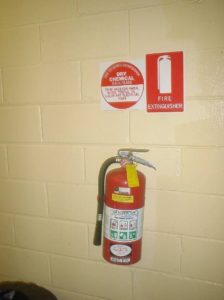Emergency Procedures
What types of emergencies may arise at work?
Emergencies that may arise at any meat processing workplace include:
- fire
- natural disasters such as flood, cyclone or heatwave
- explosion
- live animals escaping on the slaughter floor
- bomb threat
- chemical spillage
- explosive gas leak
- escape of ammonia gas
- a first aid or medical emergency.
In most cases, these emergencies will require evacuation of the workplace. All companies should have well established and documented emergency and evacuation procedures.
What is the workers role in an emergency that requires an evacuation?
All workers need to be aware of evacuation procedures. The best way to gain familiarity is to participate in regular fire drills, so that action in a real emergency is automatic. In particular, workers should be familiar with the fire exits, phone numbers of key personnel, location and use of fire extinguishers.
The procedure to raise an alarm should be clearly displayed in all work areas. All employees should be familiar with the procedure to raise the alarm and to evacuate.
In an emergency you may be told by a supervisor or fellow worker to evacuate or you may hear the evacuation siren or fire warning.
When you hear the siren you should:
- always put personal safety ahead of all else
- quickly turn off machinery but do not delay your evacuation of the building to do this
- do not turn off the lighting
- close any fire doors in the immediate area
- leave the building through the nearest EXIT and go to the assembly area
- ensure your name is marked off
- do not leave the assembly area until advised to by the Chief Fire Warden or appropriate person from your company.
What do workers need to know about fires?
There are many different types of fires. Fires may be fueled by a variety of substances including:
- wood
- paper
- flammable liquids such as petrol, oil and diesel
- flammable gases such as propane and butane
- combustible metals such as sodium and magnesium.
Fires may also be started by electrical faults.
Fire extinguishers
Only use a fire extinguisher if you have been trained to do so. Your work site will have trained personnel who are authorised to use fire extinguishers.
There are different types of fire extinguishers for each type of fire. The six most common types of fire extinguishers are water, foam, dry chemical powder, carbon dioxide, wet chemical and vaporising liquid. Care should be taken with electrical fires to first turn off the electricity. Extinguishers that contain water, foam or wet chemicals cannot be used on fires with an electrical hazard, as the electrical current would be carried to the operator. Water and wet chemicals will spread any fire involving flammable liquids.
Therefore, before a fire can safely be put out, the type of fire needs to be identified so that the correct extinguishers can be used.
Fires may only be extinguished by personnel who have been trained to do so. Trained personnel may only extinguish fires if it is safe to do so. Factors to be considered in deciding whether it is safe to fight a fire include:
- the size of the fire. The fire must be small to fight it – don’t risk personal safety
- consider exit and alternate exits
- considering the type of fire to use the correct extinguishers.

Use correct fire extinguisher for type of fire
© MINTRAC
